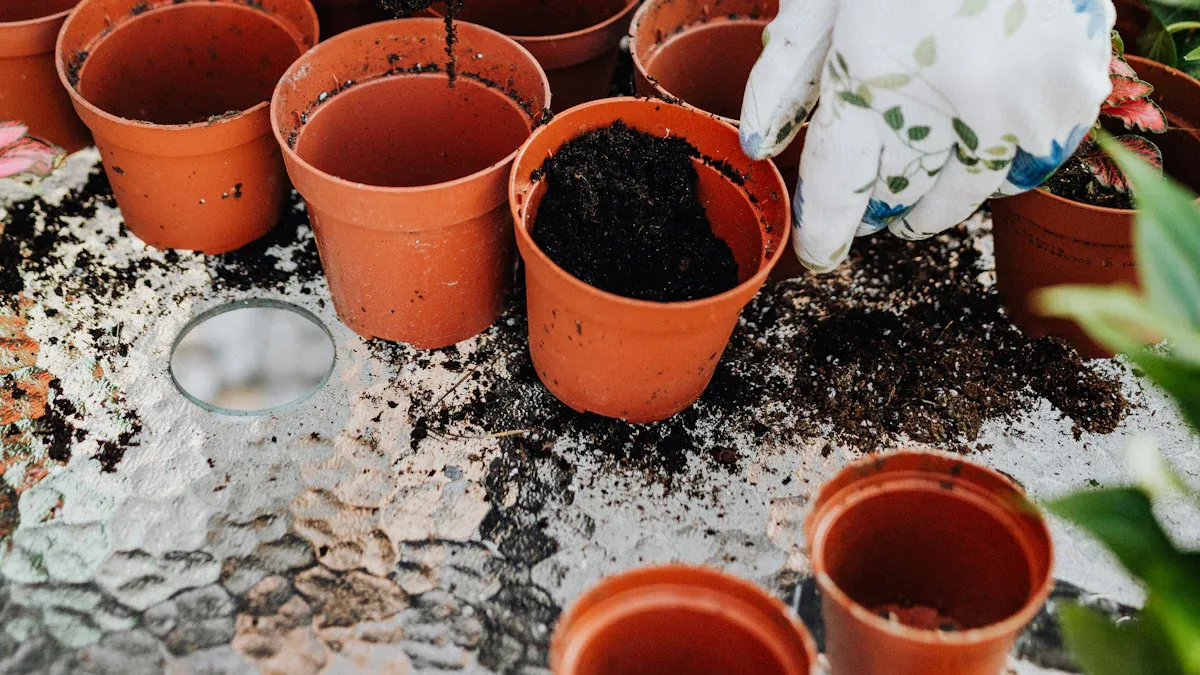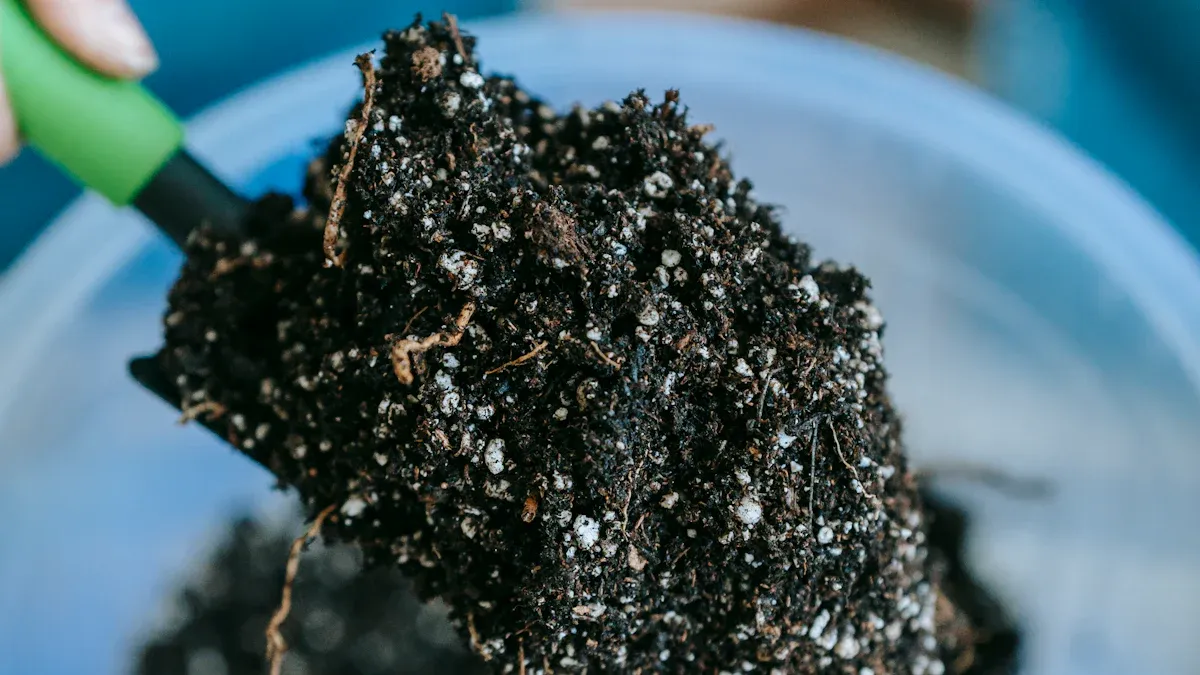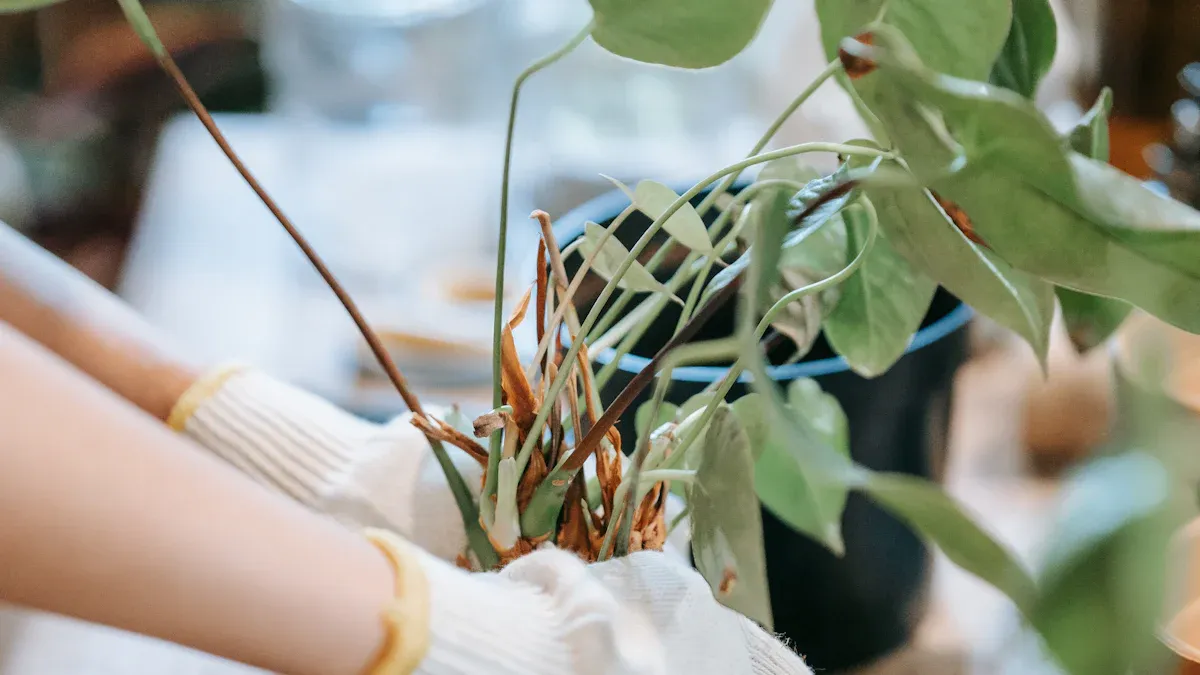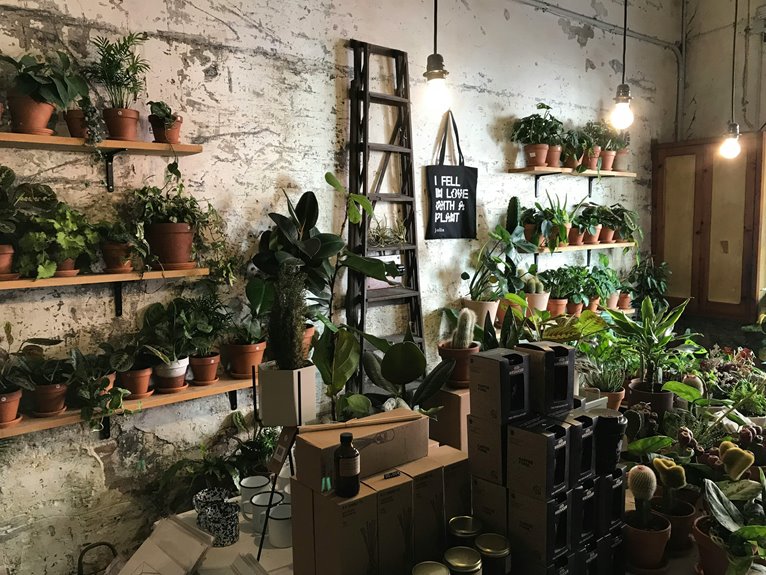
You want vibrant, healthy rose blooms in your garden. The secret for amazing roses often lies beneath the surface, specifically in your soil. Commercial mixes do not always provide the best environment for your plants. Making your own potting soil for roses gives you customization and control. This leads to superior results for your gardening efforts. You will gain better drainage, improved nutrient availability, and overall plant vigor from custom rose soil.
Key Takeaways
Making your own rose potting soil saves money and gives you control over ingredients. This helps you avoid harmful additives.
Good rose soil needs base materials like peat moss or coco coir, compost, and local garden soil. It also needs perlite or vermiculite for drainage.
Roses need nutrients. You can add bone meal, alfalfa meal, Epsom salts, or aged cow manure to your soil mix.
Roses like soil that is a little bit acidic. You can use garden lime to make soil less acidic or sulfur to make it more acidic.
To mix your soil, gather all materials, measure them carefully, and mix them well. Then, add water until the mix is damp.
Why DIY Your Rose Potting Soil?
Making your own potting soil for roses offers many advantages. You gain control and achieve better results for your plants. This approach benefits both your roses and your gardening experience.
Cost-Effectiveness
You can save money by mixing your own rose soil. Buying individual ingredients like peat moss, compost, and perlite is often cheaper. Pre-packaged commercial mixes can be expensive. Over time, these savings add up, especially if you have many roses. You invest in quality components without paying for brand names or extra packaging.
Control Over Ingredients
You know exactly what goes into your potting soil for roses. Commercial mixes sometimes contain fillers or ingredients you do not want. When you DIY, you select each component. This ensures your roses receive only the best materials. You avoid unknown chemicals or low-quality additives.
Tailoring to Rose Needs
Roses have specific requirements for their growing medium. You can customize your rose soil to meet these exact needs. Some roses prefer slightly more drainage, while others need extra nutrients. You adjust the ratios of ingredients. This creates an ideal environment for strong roots and abundant blooms. Your roses will thrive in a mix designed just for them.
Avoiding Harmful Additives
Some commercial potting mixes contain synthetic fertilizers or pesticides. These can harm beneficial soil microbes. You avoid these unwanted chemicals when you make your own. You choose organic and natural components. This creates a healthier, more sustainable environment for your roses. Your plants grow stronger without exposure to harsh substances.
Key Components for Rose Potting Soil
Crafting your own rose soil means understanding its essential building blocks. Each component plays a vital role in creating the perfect environment for your roses to flourish.
Base Materials
You need a strong foundation for your rose soil. Base materials provide the bulk of your mix.
Peat Moss/Coco Coir: These materials offer excellent water retention and aeration. Peat moss is acidic, so you might need to adjust pH. Coco coir, a sustainable alternative, comes from coconut husks. It holds nearly 10 times its weight in water. Coco coir performs comparably to peat as a soil amendment.
Consider these sustainable alternatives to peat moss:
Coconut Coir: A byproduct of the coconut industry.
Compost: A primary component in peat-free potting soil mixes.
Pine Bark (or other barks): Often used in peat-free potting soil mixes.
Perlite: A volcanic ash type that improves drainage.
Vermiculite: A mineral that expands when heated, holding more air and improving drainage.
You can even create a peat-free recipe for ornamental plants, including roses:
1 part coconut coir
1 part compost
1 part good garden topsoil
1 part builder’s sand or perlite
Compost: High-quality, well-rotted compost is crucial. It enriches your soil with organic matter and beneficial microbes. Leaf mold and mushroom compost are excellent choices. They provide a slow release of nutrients.
Local Garden Soil: You can use local garden soil as a base if it is sandy and drains quickly. Ensure it is free of pests and diseases.
Drainage and Aeration
Roses hate wet feet. Good drainage and aeration prevent root rot. These components ensure air reaches the roots.
Perlite: This lightweight, white volcanic rock is essential for aeration and drainage. Perlite’s expanded and porous nature allows it to absorb water. It simultaneously improves drainage. When you mix it into your compost, it ensures water drains freely. This prevents roots from sitting in damp soil. It also traps air within the compost. This benefits plants sensitive to moist conditions. For rose plants, perlite stone is an ideal material. It ensures good ventilation and drainage in the soil. Roses do not tolerate waterlogging. Perlite helps prevent this by promoting good drainage. It also keeps the soil from compacting. This facilitates healthy root growth for roses.
Vermiculite: This mineral expands when heated. It improves drainage and holds moisture. Vermiculite retains moisture. This helps prevent plants from drying out. It can hold up to four times its weight in water. It releases water gradually. Vermiculite has a high cation exchange capacity (CEC). This enables it to hold and slowly release nutrients.
Coarse Sand/Grit: Use coarse sand or horticultural grit sparingly. It enhances drainage. Avoid fine play sand, as it can compact the soil.
Nutrient Boosters
Roses are heavy feeders. They need a steady supply of nutrients for abundant blooms.
Bone Meal: This organic amendment provides phosphorus and calcium. Phosphorus is vital for root development. It plays a key role in initiating flower formation. Phosphorus is essential for the plant’s energy metabolism. Bone meal provides phosphorus for root development, flower initiation, and energy metabolism. Its effectiveness is not universal. It is only beneficial in soils that are acidic to neutral (pH < 7). These soils must also have low levels of available phosphorus. In many garden soils, it may be unnecessary or even counterproductive. This is especially true if the soil already contains sufficient phosphorus. It also applies if the pH is alkaline. An alkaline pH can make phosphorus unavailable to the plant.
Alfalfa Meal: This provides nitrogen and growth stimulants. Alfalfa meal provides triacontanol, a fatty acid growth stimulant, to roses. It also supplies several trace minerals. These include calcium, iron, magnesium, phosphorus, and zinc. It also contains vitamins (A, D, B1, B6, E, K, and U). Alfalfa meal contains naturally-occurring triacontanol. This growth hormone stimulates healthy root and stem development. It is also rich in micronutrients and trace minerals. These include magnesium and iron, along with vitamins such as A, B, and E.
Epsom Salts: These supply magnesium and sulfur. Magnesium is crucial for chlorophyll production. Chlorophyll is essential for photosynthesis. Epsom salt enhances chlorophyll production and bloom intensity in roses. This is primarily due to its magnesium and sulfur content. Magnesium is a crucial component of chlorophyll molecules. These are essential for photosynthesis. By increasing chlorophyll production, plants convert more sunlight into energy. This leads to vigorous growth and more flowers. Magnesium also improves the uptake of other essential nutrients. These include nitrogen and phosphorus. They are vital for flowering and root formation. This results in larger, more colorful, and robust blooms. Sulfur, another component of Epsom salt, contributes to protein synthesis. It also aids in enzyme and secondary metabolite synthesis. These include flavonoids and anthocyanins. They enhance flower pigmentation and overall bloom quality.
Greensand: This provides potassium and trace minerals. Greensand is an organic fertilizer suitable for roses. It provides approximately 10% total potash (with 0.2% soluble content). It also contains iron, magnesium, and silica. It includes up to 60 other slow-release trace minerals. This composition helps improve plant health. It enhances the soil’s ability to retain water and nutrients.
Nutrient
Percentage
Soluble Potash (K2O)
1.4%
Magnesium (Mg)
0.50%
Cobalt (CO)
0.00234%
Iron (Fe)
1.20%
Manganese (Mn)
0.05%
Aged Cow Manure: This provides a rich source of nutrients and organic matter.
Rosetone: This is a popular organic fertilizer blend specifically formulated for roses.
pH Adjusters
Roses prefer a slightly acidic to neutral pH (6.0-6.5). You might need to adjust your rose soil.
Garden Lime: Use garden lime if your soil is too acidic. It raises the pH. It also provides calcium and magnesium.
Sulfur: Use elemental sulfur if your soil is too alkaline. It lowers the pH.
Recommended DIY Potting Soil Recipes for Roses
You can create specific potting soil for roses. Different recipes suit different rose needs. These mixes help your roses grow strong and produce beautiful blooms.
Basic All-Purpose Mix
This mix works well for most roses. It provides a balanced environment for healthy growth. You can use this as a starting point for your general rose care. This basic potting soil for roses offers good drainage and nutrient availability.
Here is a general ratio breakdown for a basic all-purpose mix:
6 gallons sphagnum peat moss or coir fiber
4.5 gallons perlite
6 gallons compost
1/4 cup lime (if you use peat moss)
1 & 1/2 cup of a DIY container fertilizer blend OR 1 & 1/2 cups of any granular, complete, organic fertilizer.
You can add a handful of bone meal for extra phosphorus. This helps with root development and flowering. A small amount of alfalfa meal also boosts overall plant vigor.
Mix for Heavy Feeders
Some roses need more nutrients. These “heavy feeders” benefit from a richer rose soil. This mix provides extra food for vigorous growth and abundant flowers. You will adjust the ratios to include more nutrient boosters.
You can increase the amount of compost in your mix. Add extra bone meal and alfalfa meal. Consider these specific organic fertilizers for heavy feeders:
Mills Magic Rose Mix: This blend contains alfalfa, steamed bone meal, cottonseed, activated sludge, and organic compost activators. It has an NPK ratio of 6-5-1.
Whitney Farms Rose Food: This food includes bone meal, alfalfa meal, blood meal, feather meal, sunflower hull ash, dried poultry waste, and kelp meal. Its NPK is 4-6-2.
Dr. Earth Rose Food: This mix features cottonseed meal, fish bone meal, alfalfa meal, kelp, potassium sulfate, rock phosphate, and beneficial microbes. It has an NPK of 5-7-2.
Garden Bloom Rose Planting Mix (by Dr. Earth): This mix contains fir bark, forest humus, peat moss, perlite, worm castings, chicken manure, alfalfa meal, bat guano, bone meal, oyster shell, and dolomite limes.
Container Mix
Roses in containers need special attention. They require excellent drainage. The mix should also hold enough moisture. You must also consider the weight of the mix. A good potting mix for containers prevents compaction.
Here are several recipes for container roses:
Recipe 1: You can mix two parts existing garden soil with one part homemade compost. Add one part well-rotted manure. This provides a rich, balanced base.
Recipe 2: Combine two parts of your general rose soil with one part compost. This boosts nutrients and organic matter.
Recipe 3: Use two-thirds potting mix and one-third compost. This simple blend works well for many container roses.
Recipe 4: Mix two parts peat with two parts Peters’ topsoil. Add one part composted cow manure and one part cedar mulch. Include Rosetone and Epsom salts for extra nutrients.
Recipe 5: Add aged cow manure, compost, and bone meal to a standard potting soil. This mix provides nutrients without needing extra fertilizer right away.
Step-by-Step Guide to Mixing Your Homemade Potting Mix

Creating your own rose soil is a rewarding part of gardening. Follow these steps to mix your perfect blend.
Gathering Materials and Tools
First, collect everything you need. You will need your chosen base materials, drainage components, nutrient boosters, and pH adjusters. Gather tools like a large tarp or a wheelbarrow. A sturdy shovel or trowel helps with mixing. Wear gardening gloves to protect your hands. Have measuring cups or buckets ready for accurate proportions.
Measuring Ingredients
Accuracy makes a good homemade potting mix. Use your measuring cups or buckets to get the correct ratios. For example, if a recipe calls for “two parts compost,” use two full buckets of compost. Measure each ingredient carefully. This ensures your roses receive the right balance of nutrients and drainage.
Thorough Mixing Techniques
Now, combine your ingredients. Spread the tarp on a flat surface. Pour all your measured components onto the tarp. Use your shovel to turn the pile over and over. Mix until everything looks uniform. You should not see large clumps of any single ingredient. If you use a wheelbarrow, mix the ingredients thoroughly with your shovel. Ensure an even distribution of all components.
Moistening the Mix
Your potting mix needs some moisture before you use it. Slowly add water to the mix. Use a watering can or a hose with a gentle spray. Mix the soil as you add water. You want the mix to feel damp, like a wrung-out sponge. It should hold its shape when you squeeze it but not drip water. This pre-moistening helps the soil settle and prevents dry spots when you pot your roses.
Using Your DIY Rose Potting Soil

You have created your perfect rose soil mix. Now, learn how to use it effectively for your roses. Proper application ensures your plants thrive.
Potting New Roses
When you plant new roses, use your custom potting soil for roses. Dig a hole twice as wide as the root ball. Make the hole as deep as the root ball. Place a layer of your DIY rose soil at the bottom of the hole. Gently place the rose plant in the hole. Spread its roots out. Fill the rest of the hole with your rose soil. Lightly pat the soil around the base of the plant. Water thoroughly after planting.
Repotting Established Roses
Established roses sometimes need a new home. You should repot them when they show certain signs.
The roots need more growing room. This means you need a larger pot.
The soil needs replenishment. Roses are heavy feeders. They deplete nutrients over time.
The rose plant is becoming ‘root bound’. This means roots are circling the pot.
Choose a pot that is one size larger. Gently remove the rose from its old pot. Loosen any circling roots. Place a layer of your fresh rose soil in the new pot. Position the rose. Fill the pot with more of your mix. Water well.
Top-Dressing Rose Beds
You can refresh existing rose beds with your homemade mix. This process is called top-dressing. Spread a 1-2 inch layer of your DIY rose soil over the existing soil. Keep the soil away from the rose canes. The nutrients will slowly work their way into the ground. This boosts plant health.
Watering and Fertilizing Tips
Your DIY mix provides a great start. Continue good watering practices. Water deeply when the top inch of soil feels dry. Avoid overwatering. Your custom soil has nutrients. You may still need to fertilize regularly. Follow a feeding schedule for your specific rose type. This ensures vibrant blooms and healthy growth in your gardening efforts.
Crafting your own potting soil for roses offers many benefits. You get healthier plants and more abundant blooms. This also deepens your connection to gardening. Experiment with these recipes. Adjust them to your specific needs and observations. Nurturing roses from the ground up with a custom-made foundation is a rewarding journey.
FAQ
What is the best time to mix your own rose potting soil?
You can mix your rose potting soil any time you need it. Prepare a fresh batch before planting new roses. Mix more when you repot established plants. You can also create a larger batch to store for future use.
How long can you store homemade potting soil for roses?
You can store your homemade potting soil for up to six months. Keep it in a cool, dry place. Use an airtight container or a sealed bag. This prevents nutrient loss and keeps out pests. Freshly mixed soil offers the best results.
Can you use this DIY potting soil for other plants?
Yes, you can use this DIY potting soil for other plants. Many flowering plants benefit from similar soil conditions. Adjust the pH and nutrient boosters for specific plant needs. Always research your plant’s preferences first.
What if your water is very hard or soft?
Hard water contains many minerals. It can affect your soil’s pH over time. Soft water may lack essential minerals. You can test your water’s pH. Adjust your soil’s pH adjusters accordingly. Consider using rainwater for your roses.
How do you know if your soil pH is correct?
You can use a soil pH test kit. These kits are available at garden centers. They give you a quick reading of your soil’s acidity or alkalinity. Aim for a pH between 6.0 and 6.5 for roses. Adjust as needed with lime or sulfur.


